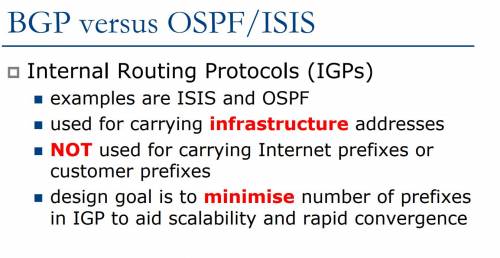Table of Contents
**BGP best practices:**
- Use route filtering to prevent the propagation of incorrect or malicious routes
- Implement route summarization to reduce the size of routing tables
- Configure BGP timers appropriately to avoid unnecessary route flapping
- Use authentication mechanisms to protect against unauthorized route updates
- Use route reflectors or confederations to reduce the number of BGP peering sessions
**OSPF best practices:**
- Use hierarchical network design to minimize the size of OSPF domains and reduce the amount of routing traffic
- Use area design to separate different types of networks and optimize routing within each area
- Configure OSPF metrics appropriately to ensure the shortest path is chosen
- Implement route summarization to reduce the size of routing tables
- Use authentication mechanisms to protect against unauthorized OSPF updates
- Overall, the best practices for BGP and OSPF focus on optimizing routing efficiency, ensuring secure communication, and minimizing the impact of routing changes on network performance. It's important for network administrators to carefully configure and maintain their BGP and OSPF settings in accordance with these best practices to ensure a stable and efficient network.
Why BGP is best better than OSPF
BGP (Border Gateway Protocol) and OSPF (Open Shortest Path First) are both routing protocols used in computer networking, but they operate in different ways and have different functions. Here are the key differences between BGP and OSPF routes, OSPF is an interior gateway protocol (IGP) used within a single autonomous system (AS), while BGP is an exterior gateway protocol (EGP) used between different ASs.
Path selection: OSPF determines the shortest path to a destination within a single AS using a metric such as cost, whereas BGP selects the best path to a destination based on a set of attributes such as the length of the AS path, the origin of the route, and the next-hop IP address.
Routing updates: OSPF shares routing information between routers in a single AS using multicast updates, while BGP uses unicast updates to exchange routing information between different ASs.
Convergence time: OSPF typically converges faster than BGP because it operates within a single AS and has more direct control over the routing environment. BGP convergence can be slower due to the larger scale of the routing table and the need to communicate with multiple ASs.
Type of routes: OSPF routes are typically based on subnet masks and are used for forwarding traffic within a single AS. BGP routes are based on network prefixes and are used for forwarding traffic between different ASs.
Why BGP in loopback ??
A loopback interface is a virtual network interface that allows a device to communicate with itself using a loopback address. In the context of BGP (Border Gateway Protocol), using a loopback interface as the source of BGP peering sessions is considered a best practice for several reasons:
Redundancy: Using a loopback interface ensures that the BGP peering session is not dependent on the physical interface or IP address of the device. If a physical interface fails or the IP address changes, the BGP peering session can still be maintained using the loopback interface.
Simplifies BGP configuration: Using a loopback interface simplifies the BGP configuration by providing a consistent source IP address for BGP peering sessions. This can make it easier to manage and troubleshoot BGP sessions, particularly in larger networks.
Improves security: Using a loopback interface can improve security by preventing the disclosure of physical interfaces and IP addresses. This can make it more difficult for attackers to target specific interfaces or devices.
Facilitates load balancing: Using a loopback interface can facilitate load balancing of BGP traffic across multiple physical interfaces. By configuring multiple BGP sessions using the same loopback address and different physical interfaces, traffic can be load balanced across those interfaces.

